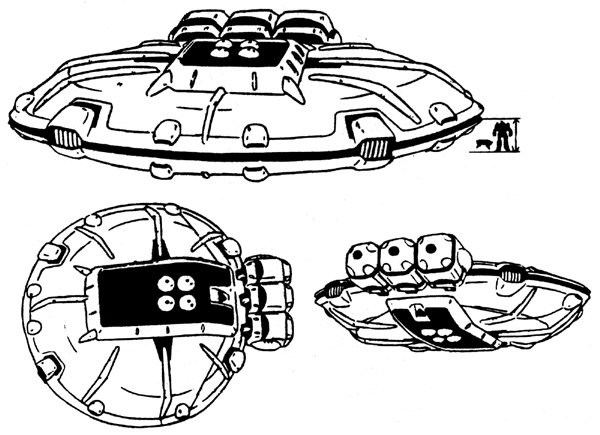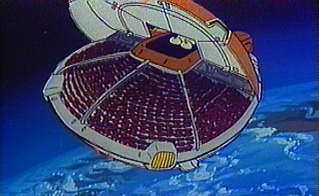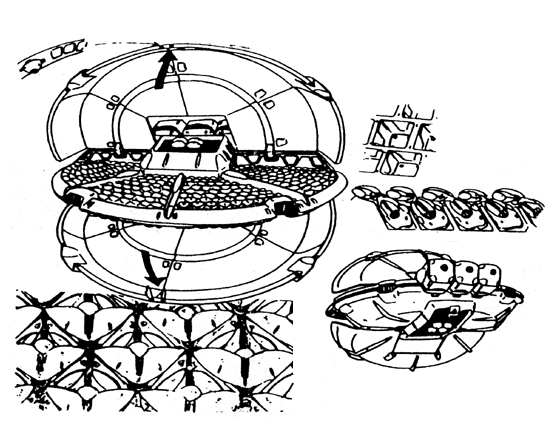

Designation:Mollusk Carrier / Shelldor |

|
||||

|
|||||
Unknown
| • | Length: | 155 meters |
| • | Width: | 122 meters |
| • | Height: | 52 meters |
| • | Mass: | 56,700 metric tons. |


The Invid standard air-mecha transport, the Mollusk Carrier, is a vaguely saucer-shaped craft with two blocky protuberances on the top and bottom, and three large thrusters bolted on at the back. There are also four highly visible maneuvering jets spaced at equal distances around the rim of the vessel. Twelve smaller jets are distributed around the vessel.
The two mecha bays take up the entire forward 40% of the vessel. Each mecha bay is subdivided into four smaller bays, two to starboard and two to port. One mecha bay is located on the dorsal side of the vessel and can be used under all circumstances, the ventral bay can only be used in space or at high altitudes - or the vessel may invert its attitude. This because the mecha would have to be launched upside-down out of this bay in a gravity well, and would not be able to assume flight attitude before crashing into the ground.
Both bays open in a very distinctive maneuver, universally known to the Invid adversaries as 'gaping' or 'opening the maw'. In this maneuver, the covering hull of the mecha bay(s) rotates up- or downwards (with the assistance of two dedicated thrusters) around the forward edge of the engineering spaces. The resulting sight is similar to that of an opening oyster.
Inside each bay can be seen the hundreds of mecha, each sitting in a dedicated launch slot in the deck of the mecha bay. The slots were designed to accommodate the Claw Fighter's engine section. In cases where planetary assault is anticipated, the Iigaa complement can be doubled if all mecha are not equipped with their boosters. An Iigaa sits in the bay where the booster is normally located, grasping onto the legs of the mecha above it. However, it was generally the case that the extra mecha could not land on the carrier. Since this configuration was only used for planetary assaults, and because of the intentionally high attrition rate of the Iigaa, this was rarely an issue. All of the mecha can be launched within seconds, greatly assisting the Invid 'superior numbers' tactic, in a mecha delivery time/numbers ratio that is unmatched in the Galaxy. So successful was this method, that the REF adapted most of their hangar bays into similar, fast-reaction Alpha launch bays.
After the Tirolian attack on Optera, the Invid prepared themselves to take their battle for the Flower and for revenge to the stars. For this, they needed spaceships. Rather than making an Invid copy of the heavily armed and armored Tirolian starships, early in the war against the Zentraedi, the Invid decided on a large number of (relatively) small Troop Carriers and Landing Boats of several designs, and a single armed gunship class. For very large-scale attacks there was also the Hive ship, a vessel that could dwarf the Robotech Masters' Motherships.
Three of the long-lived landing ship designs were based on a common shape, similar to that a seashell. The largest, called by the REF the Mollusk-class, served as a carrier of Iigaa mecha. The second, nearly as large and nearly identical in appearance except for its narrower beam, was the Oyster-class Landing Ship, Mecha. The third, which resembled a smaller version of the Mollusk, was known to the REF as the Clam-class Landing Craft, Mecha.
By far the most capable in combat was the Mollusk-class. Because it was equipped with fast aerial mecha, this ship was the Invid's supercarrier. In pitched battle this ship would appear either alone, or escorted by Trilobite-class Frigates, and while the armed warships engaged the larger Zentraedi vessels, the Mollusks would deploy their huge mecha complements and retreat to a safe distance.
This tactic did of course leave the Invid vulnerable to the heavy firepower of their enemies' starships, but usually the far superior numbers of Invid in a particular battle could easily overwhelm the numerically inferior fleets and their mecha. One factor that made this possible was the high maneuverability and cargo capacity of the Mollusk Carrier. The Zentraedi, and later the REF, found out that the best way to deal with Invid space-attacks was to destroy the Mollusk ships before they released their cargo into the battle. But as the battles over Earth showed, the Invid could usually fly in more ships than could be destroyed, and when the Invid mecha destroyed their adversaries ability to fight effectively, more and more of the Mollusk ships managed to release their mecha. Eventually, the battle hinged on whether there were more Invid than could be destroyed by the fleet before they were destroyed themselves.
The Mollusk Carrier served these tactics so well that there were no changes in the design from the first model produced soon after the introduction of the Iigaa to the last model, manufactured on Earth. There were of course, drawbacks to the design, the most major of which was the lack of any defensive or offensive weapon. The lack of any anti-mecha weapons on the Mollusk Carrier was not such a great oversight, because very few mecha ever made it through the Invid lines to the Mollusk Carriers, and even if they managed to penetrate, the Mollusk were quite maneuverable for their size, capable of dodging most attacks, as well as being of relatively simple design and easily replaced.
Go to Invid Naval Index.
Go to Robotech Reference Guide Home Page.
Robotech (R) is the property of Harmony Gold. This document is in no way intended to infringe upon their rights.
Content by Pieter Thomassen and Peter Walker